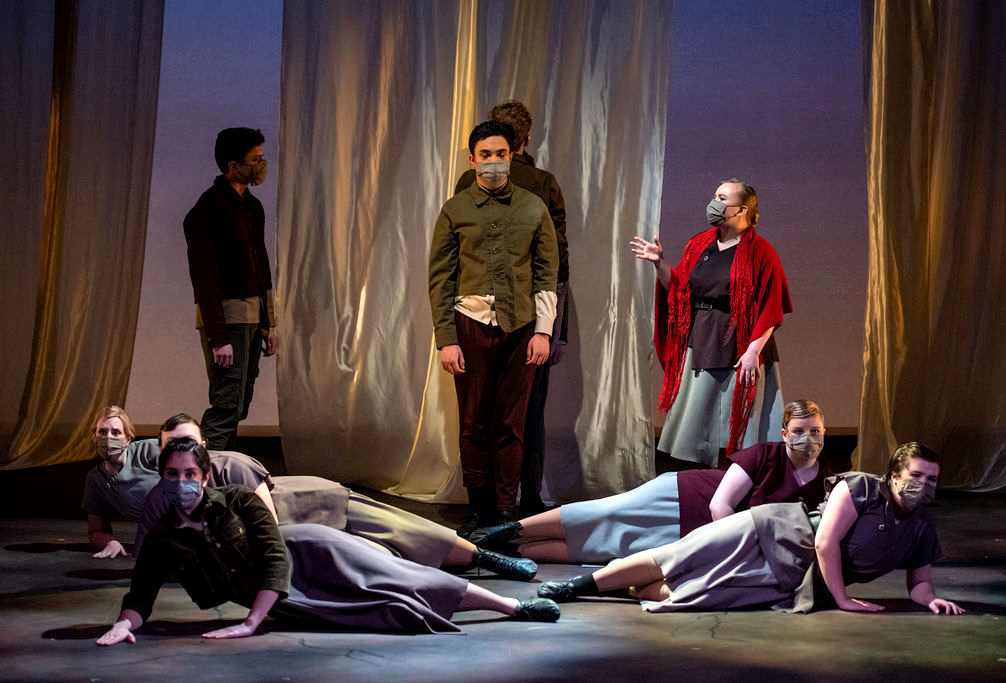A review of Phoenix Theater’s new production

The Waste Land, Phoenix Theatre’s first production of 2022, is a difficult performance to discuss — not for lack of trying, but in the way that there’s almost too much to talk about.
A retelling of T. S. Eliot’s 1922 poem of the same name, The Waste Land discusses the physical and emotional aftermath of the First World War and the Spanish Flu pandemic. The poem itself has five sections that flow through a wide range of imagery, symbolism, and perspective, often in a way that is jarring and difficult to understand.
The piece presents a fragmented view of the state of the world at the time, discussing the “Waste Land” of social values destroyed by war and disease. To impart his art, Eliot draws influence from the Bible, Buddhism, Hinduism, Shakespeare, Arthurian Legend, and satire. Overall, it’s a poem that demands careful study to fully understand.
Going into the production, I will admit that I didn’t know of the need for this context, and it was difficult at times to pry meaning out from the combination of reading and dance. But I can’t say that this production had nothing to offer me.

The most overt theme is the wasteland itself, where waters run dry, where the land lies barren, and where soldiers hunt civilians. Everyone is reacting to something, trying to extract meaning from the death of the old world and coming to terms with the reality of the new one. More deeply, this work is about the struggle of finding meaning itself after a near-apocalypse, and the narrators, despite all that they have witnessed, decide to keep searching for meaning, decide to keep on living.
Adding to this initial hurdle of understanding the narrative, perhaps, is the fact that this poem is retold through interpretive dance rather than through what would have been a flat recitation of poetry. Brought to life by the choreographer Conrad Alexandrowicz, this artistic choice adds to the piece rather than takes away.
I realize that I was watching not Eliot’s vision but Alexandrowicz’s and the actors’ interpretation of it, layers and layers of it, even through what stood out as Alexandrowicz’s unique choice to highlight the gay subtext in the poem, where other interpretations have not. Combined with the addition of someone else’s interpretation, this story is difficult to parse on its own. Nevertheless, something about the artistry of the performance itself leaves its interpretation in the hands of the audience, who must draw meaning from both the play and the dance that strings everything together.
Looking back on the whole experience, interpretive dance suits Eliot’s poetry very well. The performance moved along at a good pace, lingering within each individual moment for long enough before moving onto the next idea or section without dragging. And despite the tragedy of what the narrators have to deal with, there are brief flickers of humour scattered throughout the play. In their struggle to find meaning, the floundering can be funny to watch.
There are also no main characters: every actor has something to say, something to add; every character is equal. But this also meant that there were no real stand-out performances from any one of the actors. Despite the focus jumping around from actor to actor, the dialogue still sounded like it was written for the same one voice. The delivery fell a little flat across the cast, and when there were big jumps to the next session or next big theme, it took a moment for me to follow.
Both the poem and performance require a lot from the readers and audience. And this review is just my personal interpretation of the work. While the experience was initially confusing, upon learning the context of the original work, I was able to see things in a new, clearer light, that it wasn’t just Eliot who was struggling with the aftermath of the First World War, it was everyone who experienced it. Now knowing the context of when the poem was written, and writing this review, I find myself wanting to rewatch the dance to catch the things I missed. In that sense, I would say that the production succeeded in hooking me onto what it wants to say.
If you do decide to see The Waste Land, I hope you now have a bit more context to understand the scope of it.
The Waste Land runs Feb. 17–26, with options for both in-person viewing and streaming. Streamed performances will be held on Feb. 24 at 7 p.m., Feb. 25 at 7 p.m., and Feb. 26 at 3 p.m. Tickets can be purchased both at the Phoenix Theatre and on their website.








